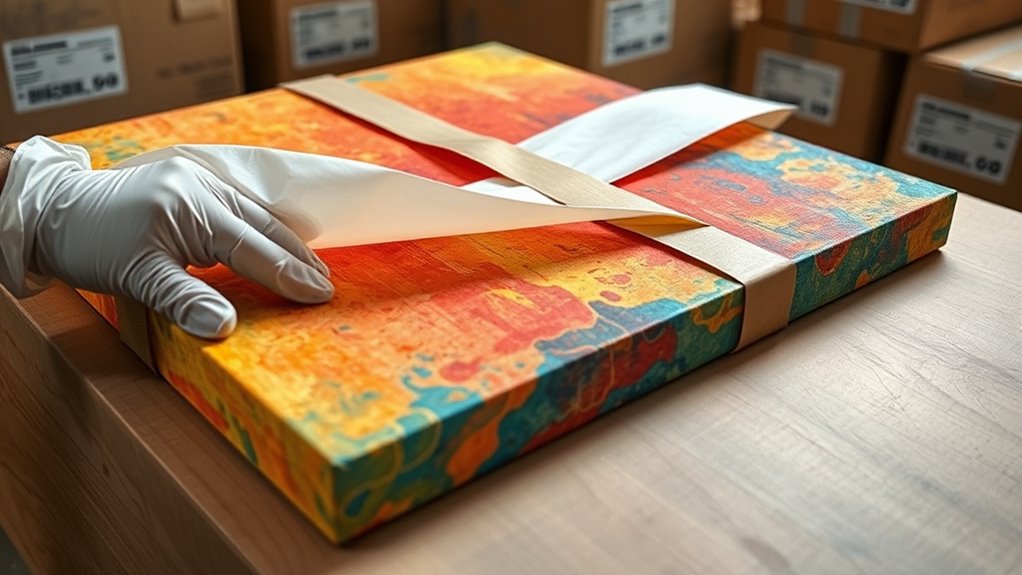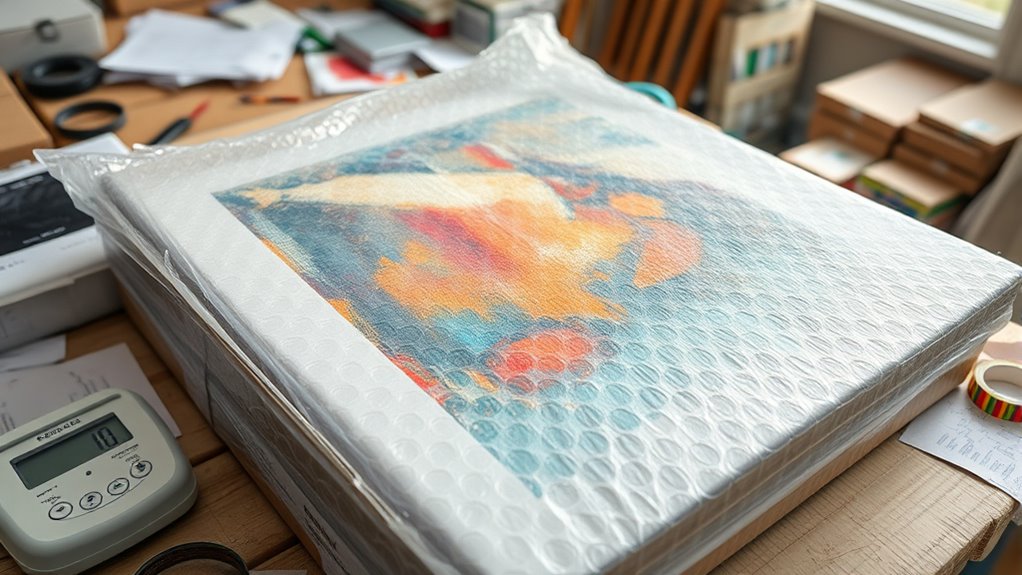To prepare your artwork for international shipping, research destination-specific customs rules and gather all necessary documentation, such as invoices and permits. Use high-quality, sturdy packaging materials like acid-free tissue, foam padding, and rigid backing to protect your piece. Label the package clearly as “Fragile” and include a detailed packing list inside. Follow carrier guidelines for handling fragile items and consider climate control if needed. Keep these tips in mind to guarantee your artwork travels safely and compliantly.
Key Takeaways
- Research and comply with destination country’s customs regulations, including necessary permits and documentation.
- Use high-quality, protective packaging materials like acid-free tissue, foam padding, and rigid backing.
- Clearly label packages as “Fragile” and include detailed packing lists for customs clearance.
- Choose appropriate shipping modes and consider climate control for sensitive artworks.
- Follow carrier-specific handling guidelines to ensure safe transit and delivery of the artwork.

Shipping artwork internationally requires careful preparation to guarantee it arrives safely and intact. One of the most vital steps is understanding customs regulations, which vary from country to country. Before you pack anything, research the specific requirements for the destination country. Some nations have strict restrictions on the types of artwork allowed or require special permits. You’ll want to confirm you have all necessary documentation, such as invoices, certificates of authenticity, and import/export permits, to avoid delays or confiscation. Failing to comply with customs regulations can lead to hefty fines, confiscation of your artwork, or even return shipments at your expense. Being proactive in understanding these rules saves you time and helps guarantee a smooth customs clearance process.
In addition to customs considerations, paying close attention to packaging requirements is essential. Your goal is to protect the artwork from physical damage, environmental factors, and rough handling during transit. Start with sturdy, high-quality materials like acid-free tissue paper and foam padding. Wrap the artwork carefully to prevent scratches, tears, or other damage. For paintings on canvas or paper, consider using a rigid backing board for support, and encase the piece in a protective sleeve if possible. When placing the artwork in the box, fill all gaps with bubble wrap or packing peanuts to prevent shifting. Seal the package securely with high-quality tape to keep it airtight and tamper-proof. Proper packaging practices are crucial to maintaining the artwork’s integrity during transit.
It’s also wise to choose packaging that’s appropriate for the mode of shipping—whether by air, sea, or land. Heavy or fragile items may require double boxing, with an outer box reinforced with corner protectors. Label the package clearly as “Fragile” and “Handle with Care” to alert handlers. Including a detailed packing list inside the package helps customs officials verify its contents quickly, reducing the risk of delays. Additionally, consider climate control options if you’re shipping artwork sensitive to temperature or humidity changes. Proper packaging not only safeguards your artwork but also demonstrates professionalism, which can influence how quickly your shipment proceeds through customs.
Lastly, always verify the shipping carrier’s guidelines regarding handling artwork. Many carriers have specific requirements for transporting fine art, and adhering to these recommendations can prevent mishaps. By thoroughly understanding customs regulations and packaging requirements, you greatly increase the chances that your artwork will arrive at its destination in perfect condition. Planning ahead, staying organized, and following best practices will give you peace of mind and guarantee your valuable artwork reaches its new home safely.
Frequently Asked Questions
How Do I Handle Fragile Artwork During International Transit?
When handling fragile artwork during international transit, you need to prioritize protection. Use sturdy artwork framing with secure, padded edges. Guarantee your packaging is robust—double-box the artwork with cushioning inside. Always account for shipping deadlines to avoid rushed packing that could damage the piece. Confirm all labels are clear and visible, and choose a reliable courier with experience in handling fragile items. This way, your artwork arrives safe and on time.
What Insurance Options Are Best for Shipped Artwork?
When choosing insurance for shipped artwork, you should focus on art insurance and shipping coverage that protect against loss or damage. Look for policies that offer thorough coverage tailored to high-value items, including theft, damage, and transit risks. Compare providers to find the best rates and coverage options. Always read the fine print to guarantee your artwork is fully protected during transit, giving you peace of mind throughout the shipping process.
Are There Specific Packaging Materials Recommended Internationally?
When shipping artwork internationally, you should use packaging materials that meet international packaging standards to guarantee safe transit. Use sturdy, shock-absorbent materials like foam or bubble wrap, and reinforce corners with corner protectors. Properly label packages for customs clearance, including detailed descriptions and value. This helps prevent delays and damage, ensuring your artwork arrives intact and complies with customs regulations across different countries.
How Do Customs Regulations Affect Artwork Shipments?
Oh, the thrill of traversing customs regulations! When you ship artwork internationally, duty fees and import restrictions become your new best friends—and occasionally, your worst enemies. You’ll need to carefully declare your masterpiece, ensuring it doesn’t get trapped in bureaucratic red tape. Ignoring these rules can lead to hefty fines or even artwork confiscation. So, stay informed, fill out paperwork accurately, and remember: customs loves surprises about as much as you love delays.
What Documentation Is Required for International Art Shipping?
When you ship artwork internationally, you need to guarantee proper documentation for customs clearance. Include detailed shipping labels that specify the contents, value, and origin of the artwork. You’ll also need a commercial invoice and any required permits or certificates, depending on the destination country. These documents help customs officials process your shipment smoothly, preventing delays or issues during transit. Always double-check specific country requirements to ensure compliance.
Conclusion
Remember, your artwork is a precious message crossing borders like a delicate butterfly on a journey. Proper packaging and labeling are its wings, protecting it from storms and rough skies. Think of each carefully wrapped piece as a passport, ready to explore new horizons. When you prepare your artwork with care, you’re not just shipping a creation—you’re sending a symbol of connection and creativity. Trust in your preparation, and let your art soar safely to its new home.









